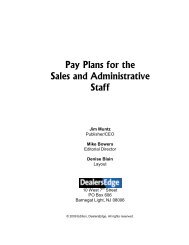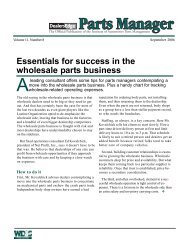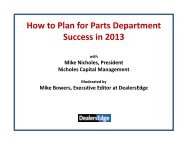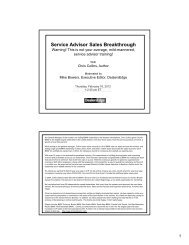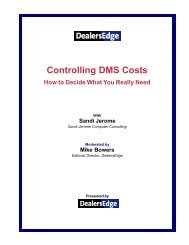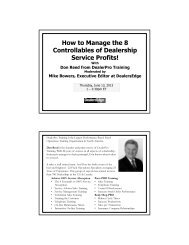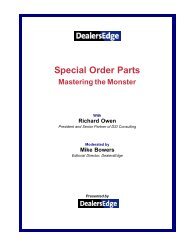How To Avoid Physical Parts Inventory Nightmares - DealersEdge
How To Avoid Physical Parts Inventory Nightmares - DealersEdge
How To Avoid Physical Parts Inventory Nightmares - DealersEdge
You also want an ePaper? Increase the reach of your titles
YUMPU automatically turns print PDFs into web optimized ePapers that Google loves.
9. Gross Profit Margin is expressed as a percentage and is calculated by dividing the grossprofit by the gross sales. The range of the gross profit margin, in an average partsdepartment, is 28-35%. <strong>How</strong>ever, before any judgment can be made on the gross margin inthe parts department a detailed analysis of the selling gross profit, by sales type, and theaccompanying percentage of business in that type must be made. If a parts department wereheavy in wholesale (if 40% or more of the total sales are wholesale) then it would be common tosee a lower overall margin. If the parts department had policies using a matrix or changed themargin in sales to the new car department, body shop, mechanical shop, wholesale or frontretail counter⎯these also could reflect in the overall margin. Before any analysis of the marginis done, review the sales by sales type chart first. A judgment of this figure is also done beforeany transfer to another department.10. <strong>Inventory</strong> (Financial Statement) also called an “actual cash value of the inventory” istaken from the financial statement for the month being analyzed. In the case of dealershipsusing LIFO accounting in the parts department, the LIFO reserve should be noted on line #11and included in the number shown on line #10. The ratio between line #3 reconciled inventoryand line #10, the G/L inventory, is considered A PRIME NUMBER FOR EVALUATION.11. LIFO reserve, if any, is noted on line #11. Again, it is important in reviewing the partsdepartment that the inventory before any accounting adjustment such as LIFO is done. There isno guide, nor opinion offered, on the use of this method of accounting and it left totally to thedecision of the dealer principle and the accountants if it is to be used.12. Gross Turn Ratio is referred to by many other names (such as: turn, dollar turn, raw turn,or simply gross turn). It is however a ratio and does not define or truly measure the number oftimes the dealerships parts investment turned relative to purchases. This figure is one of theoldest in use in the automotive and heavy duty truck industries, and many other similarindustries. It is a ratio between dollars bought (cost-of-sales) and dollars stocked (inventoryvalue on the shelf). It does not tell the dealer, or anyone else for that matter, the true efficiencyof the investment - that is done with other calculations. As a rough guideline the following isoffered:- for dealers on a daily stock orders (for over two years): 5-7- for dealers on a weekly stock orders: 4-613-16. These lines are shaded together because of the relationship they have with each other.Four lines are given on this generic checklist - three could be used and the number could beexpanded for multiple line dealerships if desired. These lines measure the purchases (bought‘smart’ or efficiently) are referred to as purchases for stock from three distinct sources. Thisarea of measurement was called stock order performance for many decades until it wasdiscovered and clarified that the parts manager had three different types and sources ofpurchasing, all three of which could be accurately deemed as wise, efficient or ‘smart’purchases, yet were technically not stock orders. The designation of this category of evaluationto Purchase Efficiency was begun in 1998 and continues to the current day.13. Purchase Efficiency [annualized] (daily or weekly or ‘RIM’ stock orders from themanufacturer annualized) are those parts purchased or acquired on the programs in place bythe manufacturer that affords the highest eventual profitability to the parts department when theparts are sold. These purchases often include, but are not limited to, discounts, obsolescencereturn credits, free freight, etc. The most important aspect of this category is that the parts,when needed by the customer, especially the technician, are available on demand thusincreasing the efficiency and profitability of the technician. The source of this information is fromthe manufacturer. Some manufacturers make this data readily available and easy to obtain (afew do not however). This category is one of three that will be used, in connection with apurchase efficiency guideline, in the parts department.4




